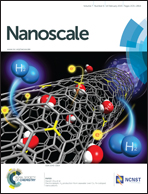Functionalized multi-walled carbon nanotubes in an aldol reaction†
Abstract
The covalent functionalization of multi-walled carbon nanotubes (MWCNTs) with a proline-based derivative is reported. Initially, MWCNTs were oxidized in order to introduce a large number of carboxylic units on their tips followed by N-tert-butoxycarbonyl-2,2′(ethylenedioxy)bis-(ethylamine) conjugation through an amide bond. Then, a proline derivative bearing a carboxylic terminal moiety at the 4-position was coupled furnishing proline-modified MWCNTs. This new hybrid material was fully characterized by spectroscopic and microscopy means and its catalytic activity in the asymmetric aldol reaction between acetone and 4-nitrobenzaldehyde was evaluated for the first time, showing to proceed almost quantitatively in aqueous media. Furthermore, several amino-modified MWCNTs were prepared and examined in the particular aldol reaction. These new hybrid materials exhibited an enhanced catalytic activity in water, contrasting with the pristine MWCNTs as well as the parent organic molecule, which failed to catalyze the reaction efficiently. Furthermore, the modified MWCNTs proved to catalyze the aldol reaction even after three repetitive cycles. Overall, a green approach for the aldol reaction is presented, where water can be employed as the solvent and modified MWCNTs can be used as catalysts, which can be successfully recovered and reused, while their catalytic activity is retained.


 Please wait while we load your content...
Please wait while we load your content...